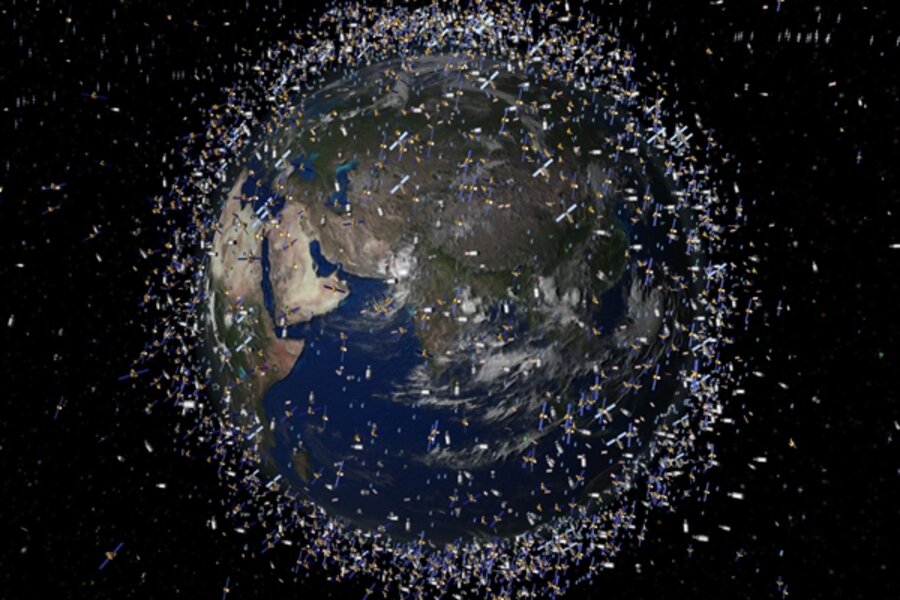Close call puts focus on traffic jam in space
Loading...
Two Space Age surprises – a close encounter between the International Space Station and a speeding piece of space junk, and an earlier collision between a US and a Russian satellite – are adding urgency to the efforts to improve collision alerts and reduce risks from space debris.
Earlier this month, the US Air Force announced that it is designing a pilot program to extend a suite of satellite tracking and debris-related services to include civilian US and foreign satellite operators. The goal is to help operators reduce the possibility that their hardware could end up as space junk.
At the UN Conference on Disarmament, currently meeting in Geneva, the European Union offered a draft voluntary “code of conduct” for reducing the risk of collisions and lowering the likelihood of adding more junk to the spent rockets, dead satellites, paint chips, a tool bag, and other detritus already orbiting Earth.
Private groups have already been building and linking data from their own space-surveillance networks to provide information to satellite operators.
The near-miss at the space station last Thursday, as well as February’s collision between a US and Russian satellite, “have served as a wake-up call,” says David Finkleman, a senior scientist at the Center for Space Standards and Innovation in Colorado Springs, Colo. The center is the research unit for Analytical Graphics, Inc. an aerospace-software company.
Currently, the US Air Force Space Command is tracking some 18,000 to 19,000 objects larger than about 4 inches that are orbiting Earth. Some specialists estimate that another 500,000 to 700,000 objects out there are smaller than 4 inches.
Of the large objects, around 900 are satellites zipping around the Earth. Roughly 45 percent of these do so in low-Earth orbit, between 100 and 1,200 miles out. This leads to hundreds if not thousands of close approaches, or conjunctions, each day.
For all the junk on orbit, there have only been eight known collisions between trackable space debris and satellites since 1991, according to data compiled by the Union of Concerned Scientists. Three of these involved active satellites. These figures don’t include damage to the space shuttle from smaller objects.
One reason satellite-on-satellite collisions don’t occur more often is that objects are mostly hundreds of miles apart, Dr. Finkleman explains. Even a close approach doesn’t necessarily translate into a high collision risk.
Still, operators tend to get antsy when the risk of a collision rises above about 1 in 10,000. “The concern is protecting investment rather than a cascading catastrophe,” says Finkelman.
For NASA, crew survival is critical, so flight controllers tend to be conservative about close passes.
Satellite operators know where their satellites are, but not necessarily know where everything else is, notes Brian Weeden, a former US Air Force captain who served with the squadron responsible for tracking and cataloging objects in space. He now consults for Secure World Foundation in Superior, Colo.
The problem close to Earth is dealing with a 50-year build-up of debris and derelicts. The issue could become at least as acute in geosynchronous orbit, some 22,000 miles from Earth. There, satellites are assigned a “box” roughly 600 miles a side. An operator may put several satellites in that box. They must all keep moving to counter the tug of war between Earth’s gravity and the moon’s, while trying to stay inside the box. At that altitude, it doesn’t take as heavy a punch to cause a problem as it does closer to Earth.
Military and civilian organizations are looking at various approaches to improving the ability to track objects. One approach involves setting up a “fence” of beams from a new generation of radar that can spot debris as small as 0.4 inches, Mr. Weeden says. It would cover low and medium Earth orbits.
For the geosynchronous orbit, commercial operators have started to feed their satellites’ position to the Space Standards and Innovation Center, which then calculates likely conjunctions and their chances of leading to a collision.
The Air Force is also exploring options to serve as an international clearing house for satellite information under its Commercial and Foreign Entities Support Pilot Program. The agency has a website for publishing the orbital and other satellite information it gathers, but Weeden points out that it doesn’t represent the most accurate information the Air Force has.
The Air Force is now looking at plans to offer services such as estimates of conjunctions, support for figuring out a satellite malfunction, or emergency help if something threatens a satellite or human life in orbit.
In the end, improving space “situational awareness” has to include greater data sharing, says Weeden. As more countries loft satellites, and the risk rises of an innocent collision being mistaken for hostile action, he says, it’s becoming clear that “you can’t do it through unilateral action."





